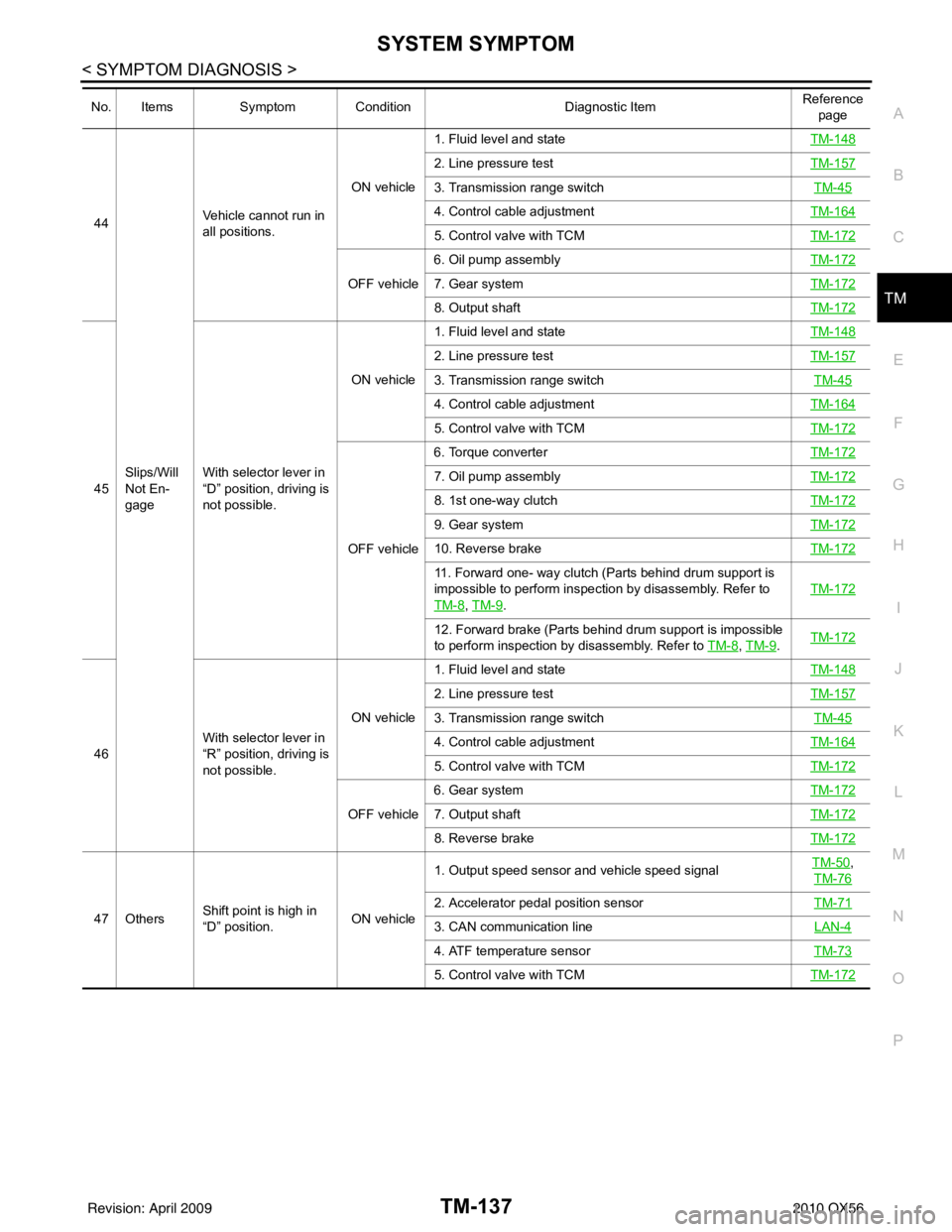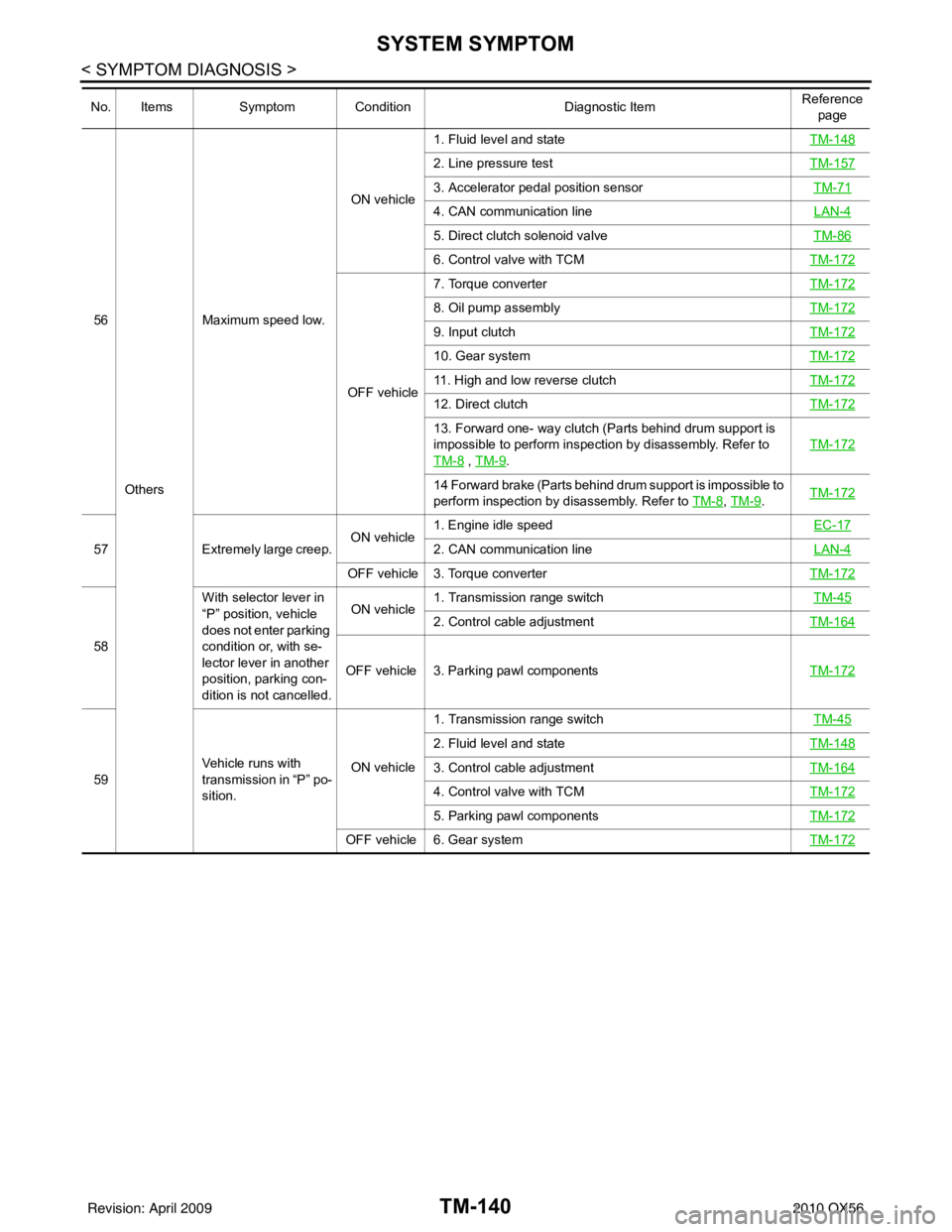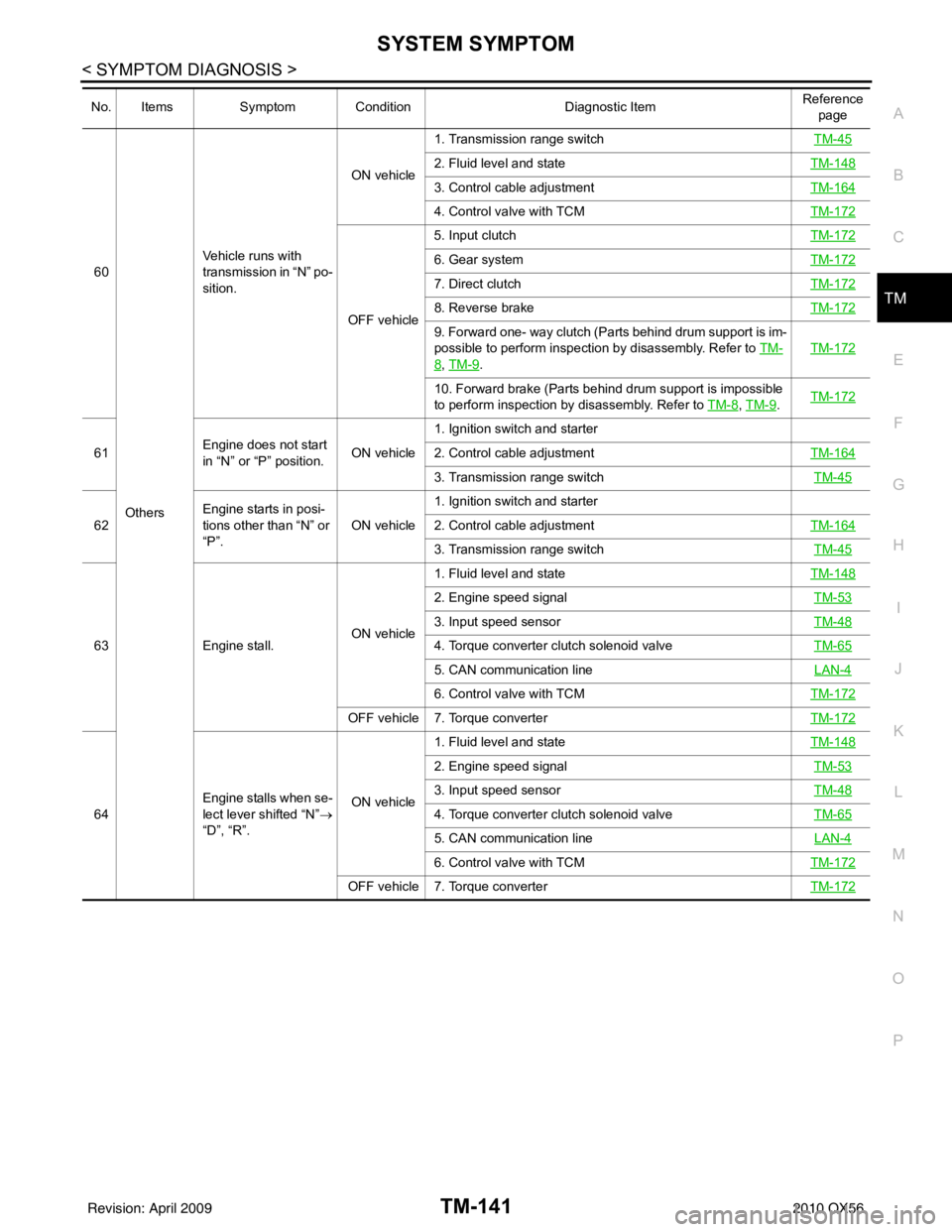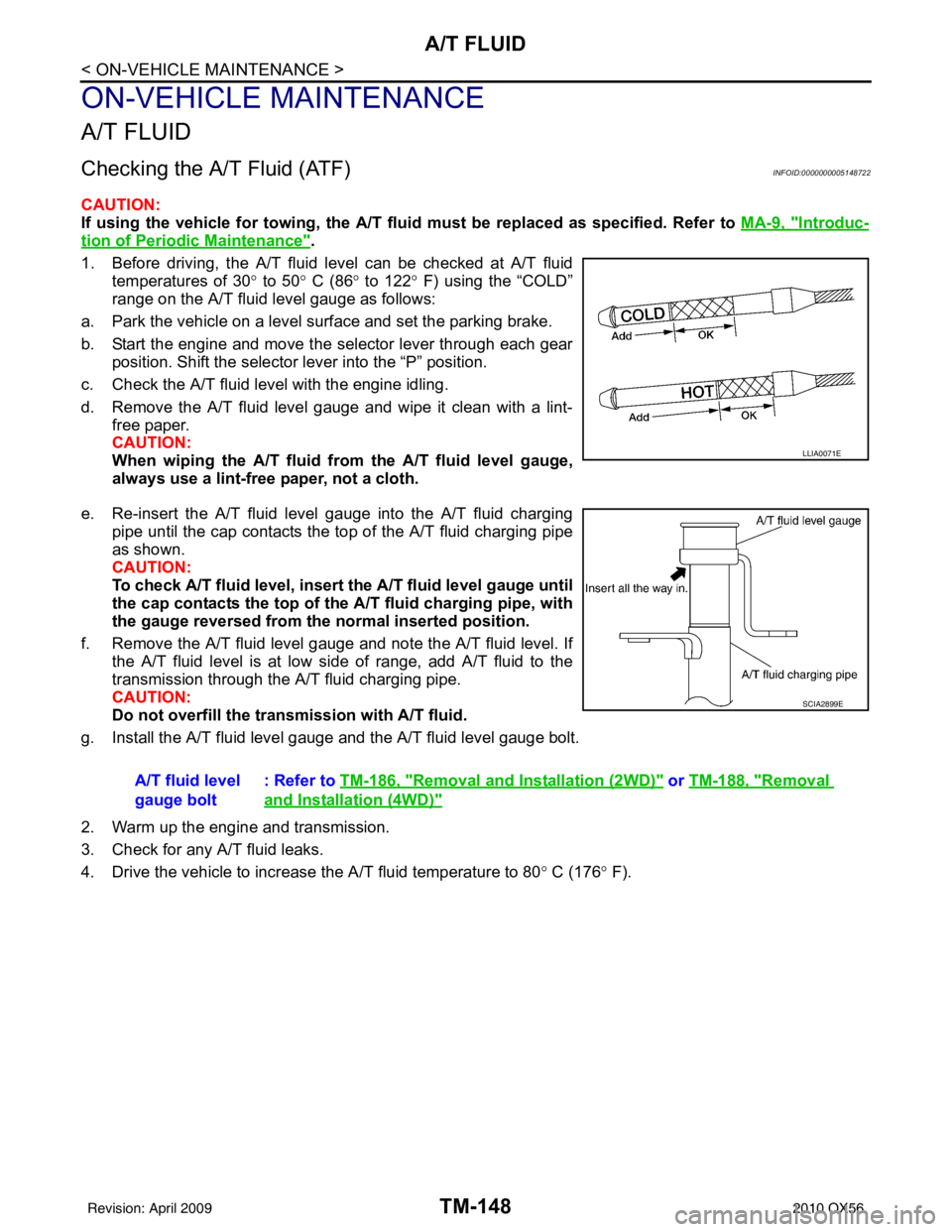Page 3832 of 4210

SYSTEM SYMPTOMTM-137
< SYMPTOM DIAGNOSIS >
CEF
G H
I
J
K L
M A
B
TM
N
O P
44
Slips/Will
Not En-
gage Vehicle cannot run in
all positions.
ON vehicle1. Fluid level and state
TM-148
2. Line pressure testTM-157
3. Transmission range switch TM-45
4. Control cable adjustmentTM-164
5. Control valve with TCMTM-172
OFF vehicle6. Oil pump assembly
TM-1727. Gear systemTM-172
8. Output shaftTM-172
45With selector lever in
“D” position, driving is
not possible. ON vehicle
1. Fluid level and state
TM-148
2. Line pressure testTM-157
3. Transmission range switch TM-45
4. Control cable adjustmentTM-164
5. Control valve with TCMTM-172
OFF vehicle6. Torque converter
TM-172
7. Oil pump assembly TM-172
8. 1st one-way clutchTM-172
9. Gear systemTM-172
10. Reverse brakeTM-172
11. Forward one- way clutch (Parts behind drum support is
impossible to perform inspection by disassembly. Refer to
TM-8
, TM-9.TM-172
12. Forward brake (Parts behind drum support is impossible
to perform inspection by disassembly. Refer to
TM-8
, TM-9. TM-172
46 With selector lever in
“R” position, driving is
not possible. ON vehicle
1. Fluid level and state
TM-148
2. Line pressure testTM-157
3. Transmission range switch TM-45
4. Control cable adjustmentTM-164
5. Control valve with TCMTM-172
OFF vehicle6. Gear system
TM-1727. Output shaftTM-172
8. Reverse brakeTM-172
47 OthersShift point is high in
“D” position. ON vehicle1. Output speed sensor and vehicle speed signal
TM-50
,
TM-76
2. Accelerator pedal position sensor TM-71
3. CAN communication line LAN-4
4. ATF temperature sensorTM-73
5. Control valve with TCMTM-172
No. ItemsSymptom Condition Diagnostic ItemReference
page
Revision: April 20092010 QX56
Page 3833 of 4210

TM-138
< SYMPTOM DIAGNOSIS >
SYSTEM SYMPTOM
48Others Shift point is low in “D”
position.
ON vehicle1. Output speed sensor and vehicle speed signal
TM-50
,
TM-76
2. Accelerator pedal position sensor TM-71
3. CAN communication line LAN-4
4. Control valve with TCMTM-172
49Judder occurs during
lock-up. ON vehicle1. Fluid level and state
TM-148
2. Engine speed signal TM-53
3. Input speed sensorTM-48
4. Output speed sensor and vehicle speed signalTM-50,
TM-76
5. Accelerator pedal position sensor TM-71
6. CAN communication line LAN-4
7. Torque converter clutch solenoid valveTM-65
8. Control valve with TCMTM-172
OFF vehicle 9. Torque converter TM-172
50Strange noise in “R”
position. ON vehicle
1. Fluid level and state
TM-148
2. Engine speed signal TM-53
3. CAN communication line LAN-4
4. Control valve with TCMTM-172
OFF vehicle5. Torque converter
TM-172
6. Oil pump assemblyTM-172
7. Gear systemTM-172
8. High and low reverse clutchTM-237
9. Reverse brakeTM-172
51Strange noise in “N”
position. ON vehicle
1. Fluid level and state
TM-148
2. Engine speed signal TM-53
3. CAN communication line LAN-4
4. Control valve with TCMTM-172
OFF vehicle5. Torque converter
TM-1726. Oil pump assemblyTM-172
7. Gear systemTM-172
52Strange noise in “D”
position. ON vehicle
1. Fluid level and state
TM-148
2. Engine speed signal TM-53
3. CAN communication line LAN-4
4. Control valve with TCMTM-172
OFF vehicle5. Torque converter
TM-172
6. Oil pump assemblyTM-172
7. Gear systemTM-172
8. Forward brake (Parts behind drum support is impossible to
perform inspection by disassembly. Refer to TM-8
, TM-9. TM-172
No. Items
Symptom Condition Diagnostic ItemReference
page
Revision: April 20092010 QX56
Page 3834 of 4210

SYSTEM SYMPTOMTM-139
< SYMPTOM DIAGNOSIS >
CEF
G H
I
J
K L
M A
B
TM
N
O P
53
Others Vehicle dose not de-
celerate by engine
brake.
ON vehicle1. Transmission range switch
TM-45
2. Fluid level and stateTM-148
3. Control cable adjustmentTM-164
4. 1st position switchTM-108
5. CAN communication line LAN-4
6. Control valve with TCMTM-172
OFF vehicle7. Input clutch
TM-1728. High and low reverse clutchTM-172
9. Direct clutchTM-172
54Engine brake does not
operate in “2” position. ON vehicle1. Transmission range switch
TM-45
2. Fluid level and stateTM-148
3. Control cable adjustmentTM-164
5. CAN communication line LAN-4
6. Control valve with TCMTM-172
OFF vehicle7. Front brake (brake band)
TM-1728. Input clutchTM-172
9. High and low reverse clutchTM-172
55Engine brake does not
operate in “1” position. ON vehicle1. Transmission range switch
TM-45
2. Fluid level and stateTM-148
3. Control cable adjustmentTM-164
4. 1st position switchTM-108
5. CAN communication line LAN-4
6. Control valve with TCMTM-172
OFF vehicle7. Input clutch
TM-1728. High and low reverse clutchTM-172
9. Direct clutchTM-172
No. ItemsSymptom Condition Diagnostic ItemReference
page
Revision: April 20092010 QX56
Page 3835 of 4210

TM-140
< SYMPTOM DIAGNOSIS >
SYSTEM SYMPTOM
56Others Maximum speed low.
ON vehicle
1. Fluid level and state
TM-148
2. Line pressure testTM-157
3. Accelerator pedal position sensor TM-71
4. CAN communication line LAN-4
5. Direct clutch solenoid valveTM-86
6. Control valve with TCMTM-172
OFF vehicle7. Torque converter
TM-172
8. Oil pump assemblyTM-172
9. Input clutchTM-172
10. Gear systemTM-172
11. High and low reverse clutchTM-172
12. Direct clutchTM-172
13. Forward one- way clutch (Parts behind drum support is
impossible to perform inspection by disassembly. Refer to
TM-8
, TM-9. TM-172
14 Forward brake (Parts behind drum support is impossible to
perform inspection by disassembly. Refer to TM-8
,
TM-9. TM-172
57
Extremely large creep. ON vehicle1. Engine idle speed
EC-172. CAN communication lineLAN-4
OFF vehicle 3. Torque converter TM-172
58With selector lever in
“P” position, vehicle
does not enter parking
condition or, with se-
lector lever in another
position, parking con-
dition is not cancelled. ON vehicle
1. Transmission range switch
TM-45
2. Control cable adjustmentTM-164
OFF vehicle 3. Parking pawl components TM-172
59Vehicle runs with
transmission in “P” po-
sition. ON vehicle1. Transmission range switch
TM-45
2. Fluid level and stateTM-148
3. Control cable adjustmentTM-164
4. Control valve with TCMTM-172
5. Parking pawl componentsTM-172
OFF vehicle 6. Gear system TM-172
No. ItemsSymptom Condition Diagnostic ItemReference
page
Revision: April 20092010 QX56
Page 3836 of 4210

SYSTEM SYMPTOMTM-141
< SYMPTOM DIAGNOSIS >
CEF
G H
I
J
K L
M A
B
TM
N
O P
60
Others Vehicle runs with
transmission in “N” po-
sition.
ON vehicle
1. Transmission range switch
TM-45
2. Fluid level and stateTM-148
3. Control cable adjustmentTM-164
4. Control valve with TCMTM-172
OFF vehicle5. Input clutch
TM-172
6. Gear systemTM-172
7. Direct clutchTM-172
8. Reverse brakeTM-172
9. Forward one- way clutch (Parts behind drum support is im-
possible to perform inspection by disassembly. Refer to TM-
8, TM-9. TM-172
10. Forward brake (Parts behind drum support is impossible
to perform inspection by disassembly. Refer to
TM-8
, TM-9. TM-172
61 Engine does not start
in “N” or “P” position. ON vehicle1. Ignition switch and starter
2. Control cable adjustment
TM-164
3. Transmission range switch TM-45
62Engine starts in posi-
tions other than “N” or
“P”. ON vehicle1. Ignition switch and starter
2. Control cable adjustment
TM-164
3. Transmission range switch TM-45
63Engine stall. ON vehicle1. Fluid level and state
TM-148
2. Engine speed signal TM-53
3. Input speed sensorTM-48
4. Torque converter clutch solenoid valveTM-65
5. CAN communication line LAN-4
6. Control valve with TCMTM-172
OFF vehicle 7. Torque converter TM-172
64Engine stalls when se-
lect lever shifted “N”
→
“D”, “R”. ON vehicle1. Fluid level and state
TM-148
2. Engine speed signal TM-53
3. Input speed sensorTM-48
4. Torque converter clutch solenoid valveTM-65
5. CAN communication line LAN-4
6. Control valve with TCMTM-172
OFF vehicle 7. Torque converter TM-172
No. ItemsSymptom Condition Diagnostic ItemReference
page
Revision: April 20092010 QX56
Page 3837 of 4210
TM-142
< SYMPTOM DIAGNOSIS >
SYSTEM SYMPTOM
65Others Engine speed does
not return to idle.
ON vehicle1. Fluid level and state
TM-148
2. Direct clutch solenoid valve TM-86
3. Front brake solenoid valveTM-84
4. Accelerator pedal position sensorTM-71
5. Output speed sensor and vehicle speed signalTM-50,
TM-76
6. CAN communication line LAN-4
7. Control valve with TCMTM-172
OFF vehicle8. Front brake (brake band)
TM-1729. Direct clutchTM-172
66A/T CHECK indicator
lamp does not come
on. ON vehicle1. CAN communication line
LAN-42. Combination meterMWI-22
3. TCM power supply TM-94
No. ItemsSymptom Condition Diagnostic ItemReference
page
Revision: April 20092010 QX56
Page 3841 of 4210
TM-146
< PREPARATION >
PREPARATION
PREPARATION
PREPARATION
Special Service ToolINFOID:0000000005148720
Tool number
Tool nameDescription
ST2505S001
Oil pressure gauge set
1. ST25051001
(—)
Oil pressure gauge
2. ST25052000
(—)
Hose
3. ST25053000
(—)
Joint pipe
4. ST25054000
(—)
Adapter
5. ST25055000
(—)
Adapter Measuring line pressure
KV31103600
Joint pipe adapter
(With ST25054000) Measuring line pressure
ST33400001
Drift Installing oil pump housing oil seal
a: 60 mm (2.36 in) dia.
b: 47 mm (1.85 in) dia.
KV31102400
Clutch spring compressor Installing reverse brake return spring retainer
a: 320 mm (12.60 in)
b: 174 mm (6.85 in)
ST25850000
Sliding hammer Remove oil pump assembly
a: 179 mm (7.05 in)
b: 70 mm (2.76 in)
c: 40 mm (1.57 in)
d: M12X1.75P
ZZA0600D
ZZA1227D
NT086
NT423
NT422
Revision: April 20092010 QX56
Page 3843 of 4210

TM-148
< ON-VEHICLE MAINTENANCE >
A/T FLUID
ON-VEHICLE MAINTENANCE
A/T FLUID
Checking the A/T Fluid (ATF)INFOID:0000000005148722
CAUTION:
If using the vehicle for towing, the A/T fluid must be replaced as specified. Refer to MA-9, "
Introduc-
tion of Periodic Maintenance".
1. Before driving, the A/T fluid level can be checked at A/T fluid temperatures of 30 ° to 50° C (86° to 122° F) using the “COLD”
range on the A/T fluid level gauge as follows:
a. Park the vehicle on a level surface and set the parking brake.
b. Start the engine and move the selector lever through each gear position. Shift the selector lever into the “P” position.
c. Check the A/T fluid level with the engine idling.
d. Remove the A/T fluid level gauge and wipe it clean with a lint- free paper.
CAUTION:
When wiping the A/T fluid from the A/ T fluid level gauge,
always use a lint-free paper, not a cloth.
e. Re-insert the A/T fluid level gauge into the A/T fluid charging pipe until the cap contacts the t op of the A/T fluid charging pipe
as shown.
CAUTION:
To check A/T fluid level, insert th e A/T fluid level gauge until
the cap contacts the top of the A/T fluid charging pipe, with
the gauge reversed from th e normal inserted position.
f. Remove the A/T fluid level gauge and note the A/T fluid level. If the A/T fluid level is at low si de of range, add A/T fluid to the
transmission through the A/T fluid charging pipe.
CAUTION:
Do not overfill the transmission with A/T fluid.
g. Install the A/T fluid level gauge and the A/T fluid level gauge bolt.
2. Warm up the engine and transmission.
3. Check for any A/T fluid leaks.
4. Drive the vehicle to increase the A/T fluid temperature to 80 ° C (176 ° F).
LLIA0071E
A/T fluid level
gauge bolt : Refer to
TM-186, "Removal and Installation (2WD)" or TM-188, "Removal
and Installation (4WD)"
SCIA2899E
Revision: April 20092010 QX56